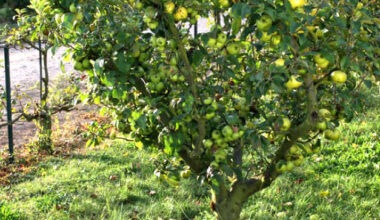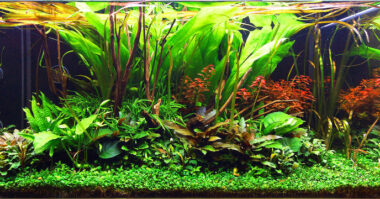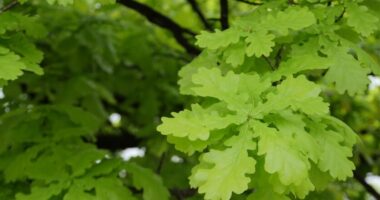The leaf is, in plant morphology, the organ specialized in photosynthesis in vascular plants. It is inserted on the stems of plants at the nodes. It is also the seat of respiration and transpiration. The leaves can specialize, in particular to store nutrients and water.
Contents
Why are the leaves of the plants/trees different?
Indeed, the leaves of the trees are certainly not identical, but they “look” very much alike. They both share two properties essential to their functions: a flat surface allowing them to capture a maximum of light necessary for photosynthesis, and a very limited thickness, thus facilitating gas exchanges (O2, CO2, water) through pores (stomata) present in their epidermis and whose opening can be regulated.
The shape of a leaf is determined by a set of specific genes that regulate the proliferation and elongation mechanisms of the cells making up the leaves. It is also known that the plant hormone “auxin” is very important for leaf growth.
General shapes of a sheet
This description of the general shape of the leaf blade can apply either to a single leaf or to a leaflet.

Whole leaf
Leaf blade that has no division, no teeth, no cut-outs and no protrusions. Example: Cherry laurel (Prunus laurocerasus).
Oval leaf
Blade which has the shape of an egg, i.e. the base is a little wider than the top. Example: Hypericum androsaemum (one of the species of St. John’s wort).
Obovate leaf
An obovate leaf is also egg-shaped, but the widest part is at the top (prefix ob=upside down). Example: Arctostaphylos uva-ursi.
Elliptical leaf
Blade in the shape of an ellipse. Small geometrical reminder, for all intents and purposes: the ellipse is the projection (the shadow) of a circle on the plane (on a surface). Example: Asclepias cornutii.
Leaf lanceolate
Blade spear-shaped, 3 to 4 times longer than it is wide, the widest part being on the side of the petiole. Example: Olea europea (olive tree).
Oblanceolate leaf
Like the previous one, spear-shaped limb, 3 to 4 times longer than wide, but the widest part being at the top and not at the base. Example: Daphne mezereum.

Kidney leaf
Blade kidney-shaped, broader than long, notched at the base and rounded at the top. Example: Farfugium japonicum.
Incised leaf
Irregularly cut blade whose incisions are deeper than simple teeth but do not reach the main rib. Example: Veronica austriaca ssp. Teucrium.
Lyriform leaf
Blade consisting of a distinctly larger, rounded upper lobe above much smaller lower lobes. Example: Rutabaga leaves.
Rusty leaf
Blade with deep, sharp, basally folded teeth. Example: Dandelion leaf. (Taraxacum dens-leonis).
Sagittarius leaf
Blade in the shape of an arrowhead. Example: Arisarum vulgare.
Hasty leaf
Blade in the shape of a halberd, the two lobes of the base being almost horizontal by difference with a sagittal leaf. Example: Atriplex hastata.

Sickle leaf
(or falsified) blade in the shape of a scythe or sickle. Example: Iris acutiloba.
Sword-shaped leaf
Blade sword-shaped (Latin “ensis” = sword, sword), long, narrow, pointed, thicker at the midrib than at the edges. Example: Eryngium yuccifolium.
Subulate leaf
blade in the shape of a shoemaker’s awl, with rather parallel edges and terminated by a point. Example: Sagina subulata.
Acicular leaf
(or aciculate, aculate-shaped) in the shape of a needle (from the Latin “acicula” = needle), elongated, thin and ending in a point. Example: the needles of conifers.
Oblong leaf
Blade much longer than wide, with nearly parallel edges. Example: Aster lateriflorus.
Linear leaf
Blade all in length, narrow and with parallel edges. Example: Carnation (Dianthus)
Ribboned sheet
Blade in the shape of a ribbon with both ends of approximately equal width. Example: Clivia nobilis.

Orbicular leaf
from the Latin “orbis” = sphere. Limb having almost the shape of a circle. Example: Cercis chinensis.
Rhomboidal leaf
(or rhombic or rhomboid) (from the Greek “rhombos” = spinning top, rhombus) limb having the shape of a rhombus. Example: Cissus rhombifolia.
Corded leaf
(or cordiform) heart-shaped limb. Example: Peperomia marmorata.
Obcorded leaf
Blade heart-shaped, but with the tip downwards, unlike the cordate leaves. Example: Oxalis stricta.
Spatulate leaf
Blade spatula-shaped, broad at the tip, narrow and elongated at the base. Example: Primula frondosa.
Panduriform leaf
Strangled limb in the middle or lower part, a bit like a figure eight or like a violin. Example: Rumex pulcher.

Acutilobed leaf
Blade whose lobes are pointed, even prickly. Example: Hepatica acutiloba.
Moon leaf
Blade in the shape of a half moon. This shape, as well as the following one, applies in particular to fern pinnules, i.e. the small subdivisions of fern fronds.
Moon-shaped leaf
Limb in the shape of crescent moon, smaller than for the moon leaf.
Wedge-shaped leaf
(or wedge-shaped) limb or inverted triangle, i.e. with the tip down. Example: Echeveria ciliata.
Peeled leaf
Leaf whose petiole is attached not to the base of the leaf blade but practically in the center of its surface, which is generally orbicular. Example: the nasturtium leafTropaelum majus.
Deltoid leaf
Blade of triangular shape, like the Greek letter “delta”. Example: Populus deltoides.
Composite leaves
Remember that a compound leaf is a leaf made up of several leaflets.

Penny leaf
As we have already seen above about the veins, a pinnate leaf is a leaf whose leaflets are arranged like the barbs of a bird’s feather, symmetrically on each side of the rachis. The rachis is the extension of the petiole for pinnate leaves.
When there is a terminal leaflet at the end of the rachis, and therefore the number of leaflets is odd, the leaf is said to be imperipenate. Example: the leaf of common vetch (Vicia sativa).
When the number of leaflets is even, the leaf is said to be paripinnate. Example: Indigofera tinctoria.
Pectinated leaf
Thin slices arranged like the teeth of a comb on each side of the spine. Example: the leaves of the yew (Taxus).
Trifoliate leaf
leaf composed of three leaflets, all attached to the top of the petiole. Example: Acer griseum. NB: the term trifoliolate is to be differentiated from the term terné which means arranged in threes. Thus, three leaves starting from the same point are said to be tarnished, and not trifoliolate, because they are not leaflets. There are also biternate (twice tarnished) or triternate (three times tarnished) arrangements.
Palm leaf
When there are more than 3 leaflets attached to the top of the petiole and fanning out, it is said to be a webbed leaf. Example: chestnut trees Aesculus californica.
Pedal leaf
The leaflets are arranged as if attached to the petiole of the previous leaflet. Example: leaf of hellebore Helleborus viridis.

Concerning pinnate leaves, if the leaflets are pinnate themselves, it is said that the leaf is bipinnate.
And if the leaflets on the second level are also pinnate, the leaf is said to be trifoliate.
Summary
In summary, leaves have more similarities than differences, a flat surface to capture maximum light, like a solar panel, and a minimal thickness, allowing easier exchange through the pores of their epidermis.
The shape of these leaves is therefore already determined in the genes of the plant or tree in question.








